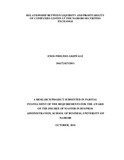| dc.description.abstract | According to Padachi (2006), a firm is required to maintain a good balance between
liquidity and profitability while conducting its daily operations. Liquidity is the
availability of funds, or assurance that funds will be available, to honor all cash
outflow commitments as they fall due (Bank of Jamaica, 2005). Pandey (2006)
suggested that a company should earn profit to survive and grow over a long period of
time. The study sought to investigate the relationship between liquidity and
profitability for companies listed at the NSE. This research was conducted through a
diagnostic research design. The diagnostic research design was considered appropriate
as it tries to determine the association of the subject matter with something else. This
study used secondary data. The secondary data was obtained from the annual financial
reports of the sampled listed firms in Kenya over a period of 5 years (2009-2013). The
data was collected based on the information about the variables. Quantitative data was
analyzed by descriptive analysis while qualitative data was analyzed through content
analysis. The study may provide information to policy makers, scholars,
academicians, finance managers and investors on the relationship between liquidity
and profitability for companies listed at the NSE. From the findings, the study
established that cash conversion period and the current ratio as liquidity measures
negatively affected the profitability of the firms listed in the NSE over the 5 year
period while the quick ratio as a liquidity measure did not significantly affect the
profitability of the firms listed in the NSE over the 5 year period. The study concludes
that there exists a significant relationship between liquidity and profitability of listed
firms in Kenya. The study recommends that the management of the firms listed in the
NSE should institute efficient cash management techniques that would help reduce
the cash conversion period. Further, the study recommends that the management of
the firms listed in the NSE should strive to achieve and maintain an optimal liquidity
position that holds adequate cash/liquid resources for operational needs while the
surplus liquid resources are invested in existing viable projects. In addition, the
management of the listed firms should focus on identifying viable investment
opportunities within the firm’s operating environment to enhance the growth and
profitability of the firms rather than paying too much attention on the liquidity
position of the firms. | en_US |

